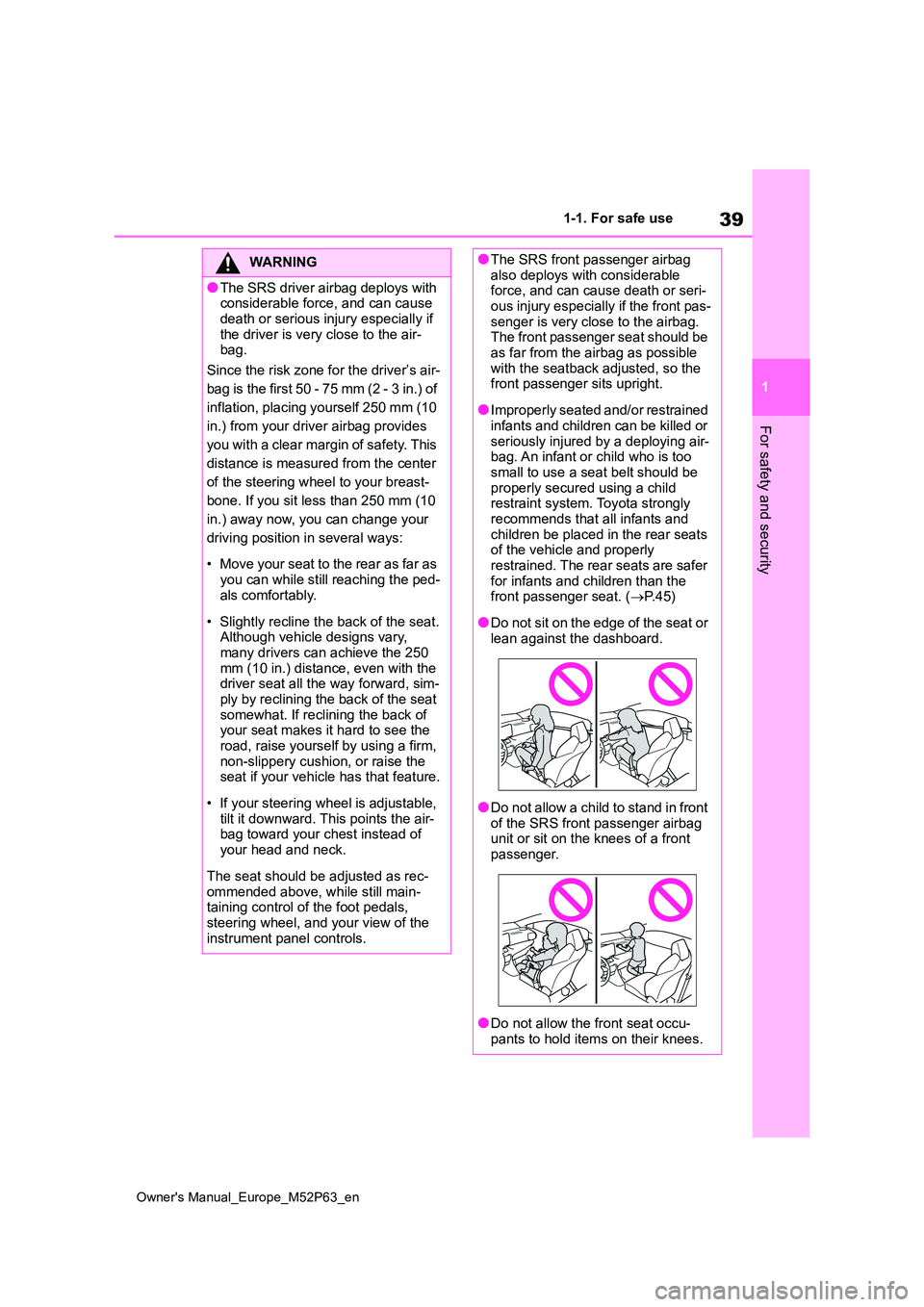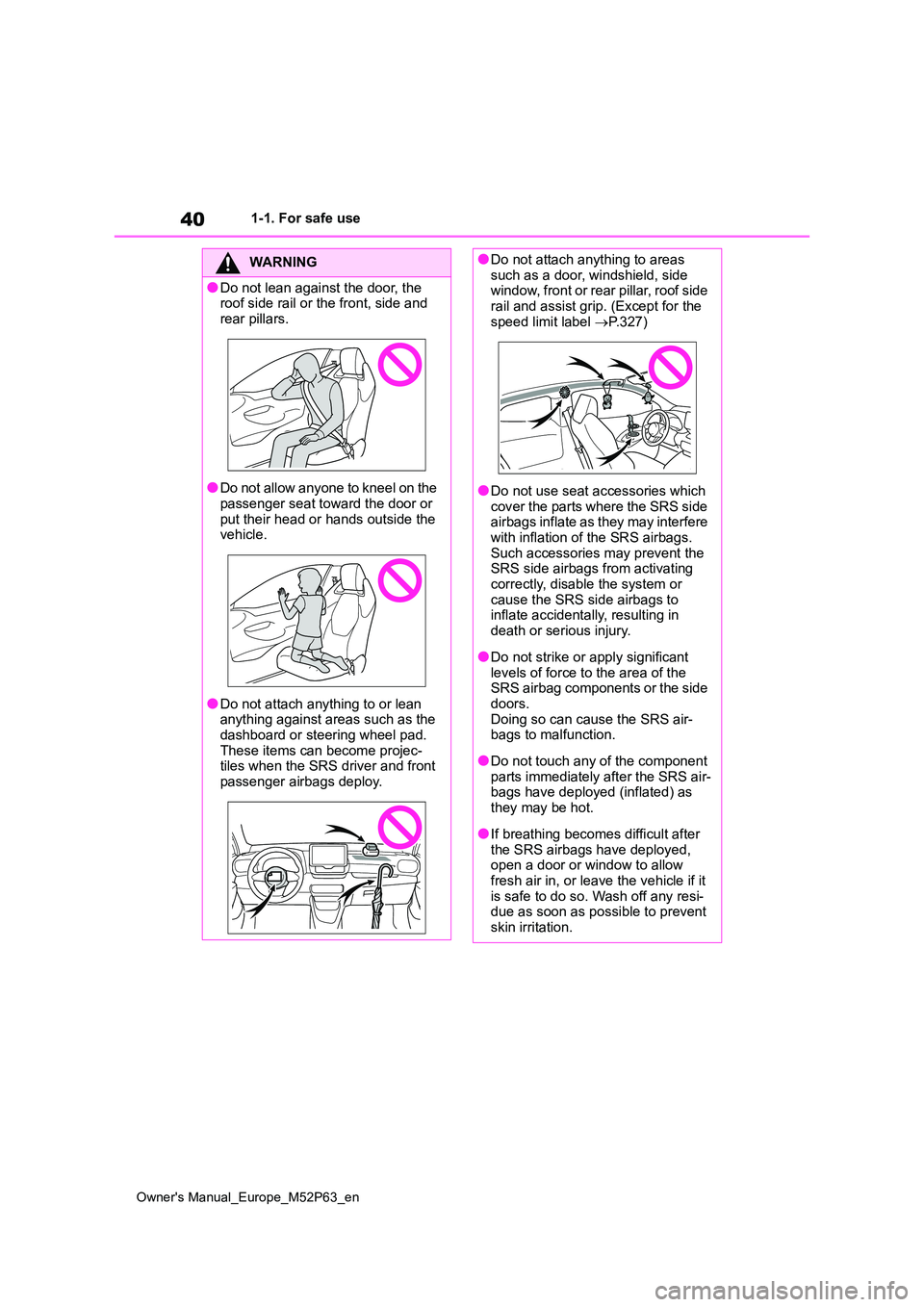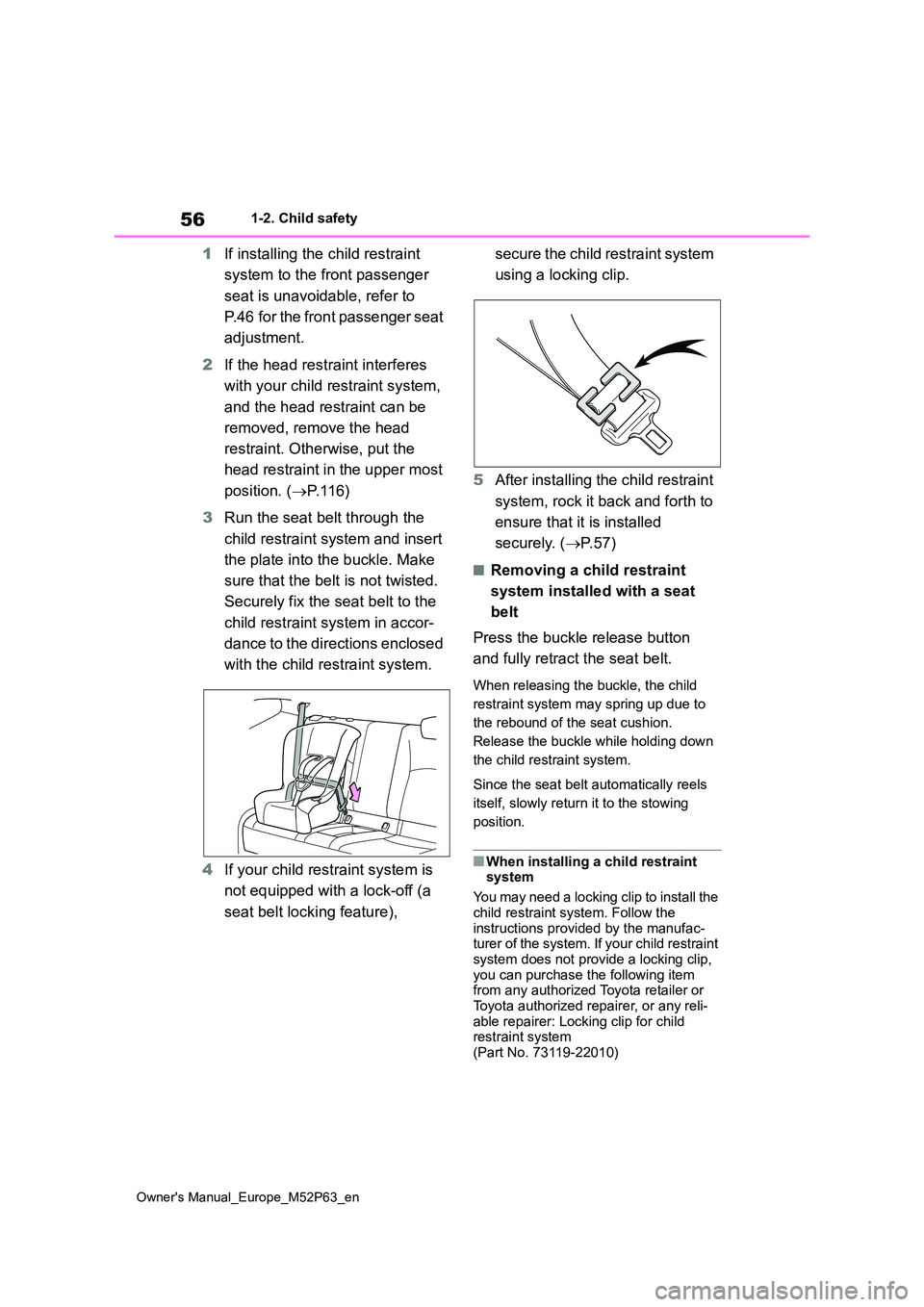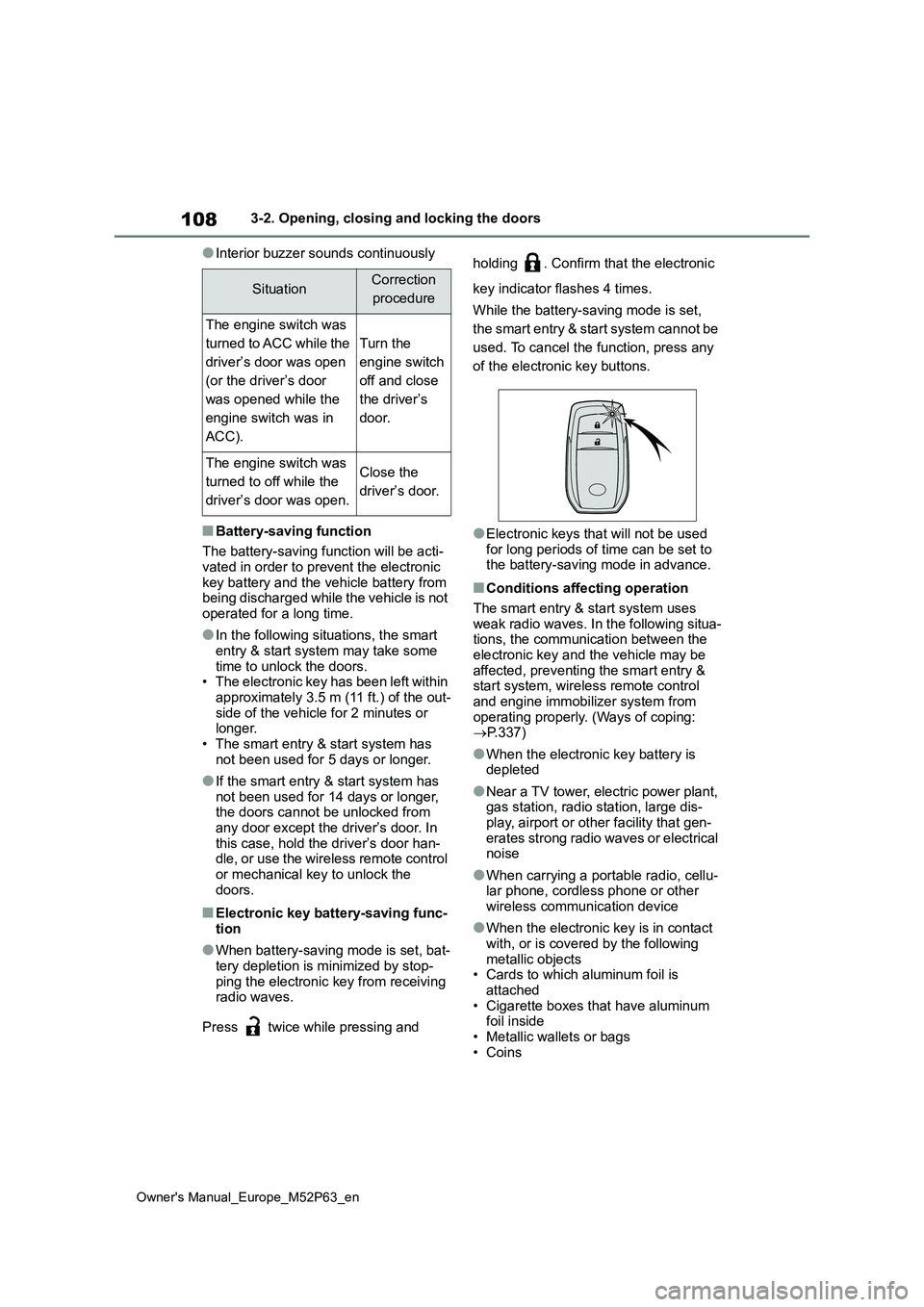2023 TOYOTA GR YARIS tow
[x] Cancel search: towPage 4 of 470

2
Owner's Manual_Europe_M52P63_en
TABLE OF CONTENTS
For your information ........................6
Reading this manual........................ 9
How to search ............................... 10
Pictorial index ................................ 12
1-1. For safe use
Before driving........................ 28
For safe driving ..................... 29
Seat belts .............................. 31
SRS airbags.......................... 34
Exhaust gas precautions ...... 41
1-2. Child safety
Airbag manual on-off system 43
Riding with children............... 44
Child restraint systems ......... 45
1-3. Emergency assistance
eCall...................................... 60
1-4. Theft deterrent system
Engine immobilizer system ... 70
Double locking system .......... 71
Alarm .................................... 72
2-1. Instrument cluster
Warning lights and indicators 78
Gauges and meters .............. 81
Multi-information display ....... 84
Head-up display .................... 90
Fuel consumption information 94
3-1. Key information
Keys ...................................... 98
3-2. Opening, closing and locking
the doors
Side doors........................... 101
Back door............................ 104
Smart entry & start system . 107
3-3. Adjusting the seats
Front seats .......................... 112
Rear seats .......................... 114
Head restraints ................... 115
3-4. Adjusting the steering wheel
and mirrors
Steering wheel .................... 118
Inside rear view mirror ........ 119
Outside rear view mirrors.... 120
3-5. Opening and closing the win-
dows
Power windows ................... 122
4-1. Before driving
Driving the vehicle .............. 126
Cargo and luggage ............. 132
Trailer towing ...................... 133
4-2. Driving procedures
Engine (ignition) switch ....... 134
Manual transmission ........... 137
Turn signal lever ................. 140
Parking brake...................... 141
1For safety and security
2Vehicle status information
and indicators
3Before driving
4Driving
Page 6 of 470

4
Owner's Manual_Europe_M52P63_en
TABLE OF CONTENTS
6-4. Do-it-yourself maintenance
Do-it-yourself service precau-
tions .................................. 265
Hood ................................... 266
Positioning a floor jack ........ 268
Engine compartment........... 269
Battery ................................ 273
Tires .................................... 275
Replacing the tire ................ 285
Tire inflation pressure ......... 288
Wheels ................................ 290
Air conditioning filter ........... 291
Wireless remote control/elec-
tronic key battery .............. 293
Checking and replacing fuses
.......................................... 295
Light bulbs .......................... 299
7-1. Essential information
Emergency flashers ............ 304
If your vehicle has to be stopped
in an emergency ............... 304
If the vehicle is trapped in rising
water ................................. 305
7-2. Steps to take in an emergency
If your vehicle needs to be towed
.......................................... 307
If you think something is wrong
.......................................... 311
Fuel pump shut off system.. 312
If a warning light turns on or a
warning buzzer sounds..... 313
If a warning message is dis-
played ............................... 321
If you have a flat tire ........... 323
If the engine will not start .... 335
If you lose your keys ........... 336
If the electronic key does not
operate properly ............... 337
If the vehicle battery is dis-
charged............................. 339
If your vehicle overheats ..... 344
If the vehicle becomes stuck
.......................................... 346
8-1. Specifications
Maintenance data (fuel, oil level,
etc.)................................... 348
Fuel information .................. 357
8-2. Customization
Customizable features ........ 359
8-3. Initialization
Items to initialize ................. 367
8-4. Certifications
Certifications ....................... 368
7When trouble arises
8Vehicle specifications
Page 16 of 470

14
Owner's Manual_Europe_M52P63_en
Pictorial index
■Instrument panel (left-hand drive vehicles)
Engine switch .................................................................................P.134
Starting the engine/changing the modes ......................... ................P.134
Emergency stop of the engine ................................... ......................P.304
When the engine will not start ................................. .........................P.335
Warning messages ............................................... ...........................P.321
Shift lever.................................................... ....................................P.137
Changing the shift position.................................... ...........................P.137
Precautions for towing ......................................... ............................P.307
Meters ......................................................... ......................................P.81
Reading the meters/adjusting the instrument panel light ........ ...........P.81
Warning lights/indicator lights ................................ ............................P.78
When a warning light turns on .................................. .......................P.313
Multi-information display ...................................... ..........................P.84
Display ........................................................ .......................................P.84
Page 22 of 470

20
Owner's Manual_Europe_M52P63_en
Pictorial index
■Instrument panel (right-hand drive vehicles)
Engine switch .................................................................................P.134
Starting the engine/changing the modes ......................... ................P.134
Emergency stop of the engine ................................... ......................P.304
When the engine will not start ................................. .........................P.335
Warning messages ............................................... ...........................P.321
Shift lever.................................................... ....................................P.137
Changing the shift position.................................... ...........................P.137
Precautions for towing ......................................... ............................P.307
Meters ......................................................... ......................................P.81
Reading the meters/adjusting the instrument panel light ........ ...........P.81
Warning lights/indicator lights ................................ ............................P.78
When a warning light turns on .................................. .......................P.313
Multi-information display ...................................... ..........................P.84
Display ........................................................ .......................................P.84
Page 41 of 470

39
1
Owner's Manual_Europe_M52P63_en
1-1. For safe use
For safety and security
WARNING
●The SRS driver airbag deploys with considerable force, and can cause
death or serious injury especially if the driver is very close to the air-bag.
Since the risk zone for the driver’s air-
bag is the first 50 - 75 mm (2 - 3 in.) of
inflation, placing yourself 250 mm (10
in.) from your driver airbag provides
you with a clear margin of safety. This
distance is measured from the center
of the steering wheel to your breast-
bone. If you sit less than 250 mm (10
in.) away now, you can change your
driving position in several ways:
• Move your seat to the rear as far as
you can while still reaching the ped- als comfortably.
• Slightly recline the back of the seat. Although vehicle designs vary, many drivers can achieve the 250
mm (10 in.) distance, even with the driver seat all the way forward, sim-ply by reclining the back of the seat
somewhat. If reclining the back of your seat makes it hard to see the road, raise yourself by using a firm,
non-slippery cushion, or raise the seat if your vehicle has that feature.
• If your steering wheel is adjustable, tilt it downward. This points the air-bag toward your chest instead of
your head and neck.
The seat should be adjusted as rec-
ommended above, while still main- taining control of the foot pedals, steering wheel, and your view of the
instrument panel controls.
●The SRS front passenger airbag also deploys with considerable force, and can cause death or seri-
ous injury especially if the front pas- senger is very close to the airbag. The front passenger seat should be
as far from the airbag as possible with the seatback adjusted, so the front passenger sits upright.
●Improperly seated and/or restrained infants and children can be killed or
seriously injured by a deploying air- bag. An infant or child who is too small to use a seat belt should be
properly secured using a child restraint system. Toyota strongly recommends that all infants and
children be placed in the rear seats of the vehicle and properly restrained. The rear seats are safer
for infants and children than the front passenger seat. ( P. 4 5 )
●Do not sit on the edge of the seat or lean against the dashboard.
●Do not allow a child to stand in front of the SRS front passenger airbag unit or sit on the knees of a front
passenger.
●Do not allow the front seat occu-
pants to hold items on their knees.
Page 42 of 470

40
Owner's Manual_Europe_M52P63_en
1-1. For safe use
WARNING
●Do not lean against the door, the roof side rail or the front, side and
rear pillars.
●Do not allow anyone to kneel on the
passenger seat toward the door or put their head or hands outside the vehicle.
●Do not attach anything to or lean anything against areas such as the
dashboard or steering wheel pad. These items can become projec-tiles when the SRS driver and front
passenger airbags deploy.
●Do not attach anything to areas such as a door, windshield, side window, front or rear pillar, roof side
rail and assist grip. (Except for the speed limit label P.327)
●Do not use seat accessories which cover the parts where the SRS side airbags inflate as they may interfere
with inflation of the SRS airbags. Such accessories may prevent the SRS side airbags from activating
correctly, disable the system or cause the SRS side airbags to inflate accidentally, resulting in
death or serious injury.
●Do not strike or apply significant
levels of force to the area of the SRS airbag components or the side doors.
Doing so can cause the SRS air- bags to malfunction.
●Do not touch any of the component parts immediately after the SRS air-bags have deployed (inflated) as
they may be hot.
●If breathing becomes difficult after
the SRS airbags have deployed, open a door or window to allow fresh air in, or leave the vehicle if it
is safe to do so. Wash off any resi- due as soon as possible to prevent skin irritation.
Page 58 of 470

56
Owner's Manual_Europe_M52P63_en
1-2. Child safety
1If installing the child restraint
system to the front passenger
seat is unavoidable, refer to
P.46 for the front passenger seat
adjustment.
2 If the head restraint interferes
with your child restraint system,
and the head restraint can be
removed, remove the head
restraint. Otherwise, put the
head restraint in the upper most
position. ( P. 1 1 6 )
3 Run the seat belt through the
child restraint system and insert
the plate into the buckle. Make
sure that the belt is not twisted.
Securely fix the seat belt to the
child restraint system in accor-
dance to the directions enclosed
with the child restraint system.
4 If your child restraint system is
not equipped with a lock-off (a
seat belt locking feature),
s e c u r e t h e c h i l d r e s t r a i n t s y s t e m
using a locking clip.
5 After installing the child restraint
system, rock it back and forth to
ensure that it is installed
securely. ( P. 5 7 )
■Removing a child restraint
system installed with a seat
belt
Press the buckle release button
and fully retract the seat belt.
When releasing the buckle, the child
restraint system may spring up due to
the rebound of the seat cushion.
Release the buckle while holding down
the child restraint system.
Since the seat belt automatically reels
itself, slowly return it to the stowing
position.
■When installing a child restraint system
You may need a locking clip to install the
child restraint system. Follow the instructions provided by the manufac-turer of the system. If your child restraint
system does not provide a locking clip, you can purchase the following item from any authorized Toyota retailer or
Toyota authorized repairer, or any reli- able repairer: Locking clip for child restraint system
(Part No. 73119-22010)
Page 110 of 470

108
Owner's Manual_Europe_M52P63_en
3-2. Opening, closing and locking the doors
●Interior buzzer sounds continuously
■Battery-saving function
The battery-saving function will be acti-
vated in order to prevent the electronic key battery and the vehicle battery from being discharged while the vehicle is not
operated for a long time.
●In the following situations, the smart
entry & start system may take some time to unlock the doors.• The electronic key has been left within
approximately 3.5 m (11 ft.) of the out- side of the vehicle for 2 minutes or longer.
• The smart entry & start system has not been used for 5 days or longer.
●If the smart entry & start system has not been used for 14 days or longer, the doors cannot be unlocked from
any door except the driver’s door. In this case, hold the driver’s door han-dle, or use the wireless remote control
or mechanical key to unlock the doors.
■Electronic key battery-saving func-tion
●When battery-saving mode is set, bat-tery depletion is minimized by stop-
ping the electronic key from receiving radio waves.
Press twice while pressing and
holding . Confirm that the electronic
key indicator flashes 4 times.
While the battery-saving mode is set,
the smart entry & start system cannot be
used. To cancel the function, press any
of the electronic key buttons.
●Electronic keys that will not be used for long periods of time can be set to the battery-saving mode in advance.
■Conditions affecting operation
The smart entry & start system uses weak radio waves. In the following situa-tions, the communication between the
electronic key and the vehicle may be affected, preventing the smart entry & start system, wireless remote control
and engine immobilizer system from operating properly. (Ways of coping: P.337)
●When the electronic key battery is depleted
●Near a TV tower, electric power plant, gas station, radio station, large dis-
play, airport or other facility that gen- erates strong radio waves or electrical noise
●When carrying a portable radio, cellu-lar phone, cordless phone or other
wireless communication device
●When the electronic key is in contact
with, or is covered by the following metallic objects• Cards to which aluminum foil is
attached • Cigarette boxes that have aluminum foil inside
• Metallic wallets or bags •Coins
SituationCorrection
procedure
The engine switch was
turned to ACC while the
driver’s door was open
(or the driver’s door
was opened while the
engine switch was in
ACC).
Turn the
engine switch
off and close
the driver’s
door.
The engine switch was
turned to off while the
driver’s door was open.
Close the
driver’s door.